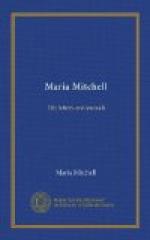“Among other things, we were shown the ’Magna Charta’—a few fragments of worn-out paper on which some words could be traced; now carefully preserved in a frame, beneath a glass.
“Thus far England has impressed me seriously; I cannot imagine how it has ever earned the name of ‘Merrie England.’
“August 19. There are four great men whose haunts I mean to seek, and on whose footsteps I mean to stand: Newton, Shakspere, Milton, and Johnson.
“To-day I told the driver to take me to St. Martin’s, where the guide-book says that Newton lived. He put me down at the Newton Hotel, but I looked in vain to its top to see anything like an observatory.
“I went into a wine-shop near, and asked a girl, who was pouring out a dram, in which house Newton lived. She pointed, not to the hotel, but to a house next to a church, and said, ’That’s it—don’t you see a place on the top? That’s where he used to study nights.’
“It is a little, oblong-shaped observatory, built apparently of wood, and blackened by age. The house is a good-looking one—it seems to be of stone. The girl said the rooms were let for shops.
“Next I told the driver to take me to Fleet street, to Gough square, and to Bolt court, where Johnson lived and died.
“Bolt court lies on Fleet street, and it is but few steps along a narrow passage to the house, which is now a hotel, where Johnson died; but you must walk on farther through the narrow passage, a little fearful to a woman, to see the place where he wrote the dictionary. The house is so completely within a court, in which nothing but brick walls could be seen, that one wonders what the charm of London could be, to induce one to live in that place. But a great city always draws to itself the great minds, and there Johnson probably found his enjoyment.
“August 27. We took St. Paul’s Church to-day. We took tickets for the vaults, the bell, the crypt, the whispering-gallery, the clock and all. We did not know what was before us. It was a little tiresome as far as the library and the room of Nelson’s trophies, but to my surprise, when the guide said, ‘Go that way for the clock,’ he did not take the lead, but pointed up a staircase, and I found myself the pioneer in the narrowest and darkest staircase I ever ascended. It was really perfect darkness in some of the places, and we had to feel our way. We all took a long breath when a gleam of light came in at some narrow windows scattered along. At the top, in front of the clock works, stood a woman, who began at once to tell us the statistics of the pendulum, to which recital I did not choose to listen. She was not to go down with us, and, panting with fatigue and trembling with fright, we groped our way down again.
“There was another long, but easy, ascent to the ‘whispering-gallery,’ which is a fine place from which to look down upon the interior of the church. The man in attendance looked like a respectable elderly gentleman. He told us to go to the opposite side of the gallery, and he would whisper to us. We went around, and, worn out with fatigue, dropped upon a bench.




